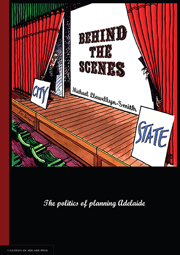Book contents
- Frontmatter
- Contents
- List of Figures and Tables
- Abbreviations
- Acknowledgements
- Foreword
- Introduction
- 1 The background to the founding of Adelaide and South Australia in 1836
- 2 The development of the City and State from 1840 until 1950 and the City/State relationship during this period
- 3 Changing attitudes to planning the City and State from 1950 until 1972
- 4 The establishment of the City of Adelaide Development Committee and the introduction of Interim Development Control
- 5 Planning in Sydney and the work of George Clarke
- 6 The City of Adelaide Planning Study
- 7 Converting the City of Adelaide Planning Study into a City Plan
- 8 An innovative system of city planning from 1 March 1977
- 9 Changes in the ACC and the State, and the first Heritage Study of the City
- 10 The operation of the City's planning system from November 1982 until May 1987
- 11 The Condous Lord Mayoralty and the declining importance of the City of Adelaide Planning Commission
- 12 The State Planning Review, the last City Plan and the end of the City's separate system
- Conclusion
- Appendix 1 Key People of Influence identified as potential interviewees
- Appendix 2 Heritage Summary Assessment Sheet
- Bibliography
- Index
Conclusion
Published online by Cambridge University Press: 05 June 2013
- Frontmatter
- Contents
- List of Figures and Tables
- Abbreviations
- Acknowledgements
- Foreword
- Introduction
- 1 The background to the founding of Adelaide and South Australia in 1836
- 2 The development of the City and State from 1840 until 1950 and the City/State relationship during this period
- 3 Changing attitudes to planning the City and State from 1950 until 1972
- 4 The establishment of the City of Adelaide Development Committee and the introduction of Interim Development Control
- 5 Planning in Sydney and the work of George Clarke
- 6 The City of Adelaide Planning Study
- 7 Converting the City of Adelaide Planning Study into a City Plan
- 8 An innovative system of city planning from 1 March 1977
- 9 Changes in the ACC and the State, and the first Heritage Study of the City
- 10 The operation of the City's planning system from November 1982 until May 1987
- 11 The Condous Lord Mayoralty and the declining importance of the City of Adelaide Planning Commission
- 12 The State Planning Review, the last City Plan and the end of the City's separate system
- Conclusion
- Appendix 1 Key People of Influence identified as potential interviewees
- Appendix 2 Heritage Summary Assessment Sheet
- Bibliography
- Index
Summary
THE UNIQUENESS OF ADELAIDE
The history of William Light's plan for Adelaide, particularly its siting and the Park Lands, is a very important element in the growth of the City and the State and is the ‘creative tension’ in the political relationship that developed between the ACC and State Government from 1840. In Bill Peach's view, the free-settled nature of the colony of South Australia contributed to the civilised qualities of Adelaide that has made the City different and special. But it is the continuous belt of Park Lands that makes Adelaide unique and which gives the City its distinctive character as a city in a garden. The City of Adelaide is one of the few cities in the world whose boundaries have not altered since their foundation. The Park Lands provide a clear boundary and sense of identity; whether walking, cycling or driving, you have to pass through them to get to the City. Of all the Australian capital cities, only in Adelaide is there physical evidence separating the centre from the surrounding other local government areas. A good example of this distinctive quality is to compare the boundaries of the City of Adelaide (Figure 1, Introduction) with the boundaries of the City of Sydney in 1971 (Figure 22, Chapter 4).
- Type
- Chapter
- Information
- Behind the ScenesThe politics of planning Adelaide, pp. 333 - 344Publisher: The University of Adelaide PressPrint publication year: 2012



